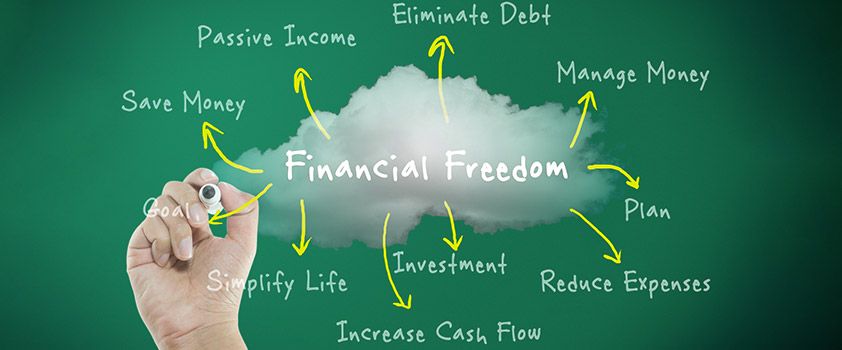

Financial freedom is a goal many aspire to achieve, but few truly understand what it means or how to get there. It’s about having enough resources to live comfortably without constantly worrying about money. Let’s learn more about this topic below with Monkey Mart. In this article, we’ll explore the concept of financial freedom and provide actionable strategies to help you attain it before turning 40.
Financial freedom is more than just having a lot of money. It’s about reaching a point where your passive income exceeds your living expenses, allowing you to make choices based on what you want rather than what you can afford. This state of financial well-being provides security, reduces stress, and opens up opportunities for personal growth and fulfillment.
Achieving financial freedom before 40 requires a combination of smart financial planning, disciplined saving, and strategic investing. It’s not about getting rich quick, but rather about making consistent, informed decisions that compound over time. By starting early and staying committed to your financial goals, you can set yourself up for a life of financial independence.
Reaching financial freedom before 40 is an ambitious goal, but it’s certainly achievable with the right approach. Here are some crucial steps to help you on your journey:
The foundation of financial freedom is a well-thought-out financial plan. Start by assessing your current financial situation, including your income, expenses, assets, and debts. Set clear, measurable goals for where you want to be financially by the time you’re 40. Your plan should include both short-term and long-term objectives, such as paying off debt, building an emergency fund, and saving for retirement.
Be realistic but ambitious in your goal-setting. Consider factors like your career trajectory, potential income growth, and lifestyle changes. Remember, your financial plan is not set in stone; it should be flexible enough to adapt to life changes and new opportunities.
Effective budgeting is crucial for achieving financial freedom. Track your income and expenses meticulously to understand where your money is going. Use budgeting apps or spreadsheets to categorize your spending and identify areas where you can cut back. Implement the 50/30/20 rule: allocate 50% of your income to needs, 30% to wants, and 20% to savings and debt repayment.
Focus on reducing unnecessary expenses and finding ways to live below your means. This doesn’t mean depriving yourself of all pleasures, but rather making conscious choices about where to spend your money. Look for ways to reduce major expenses like housing and transportation, as these often consume a significant portion of income.
Debt is one of the biggest obstacles to financial freedom. Prioritize paying off high-interest debt, such as credit card balances, as quickly as possible. Consider debt consolidation or balance transfer options to reduce interest payments. Once you’ve cleared your high-interest debt, focus on paying off other loans like student debt or car loans.
Moving forward, avoid taking on new debt unless absolutely necessary. If you must use credit, do so responsibly and always have a plan to pay it off quickly. Remember, every dollar you pay in interest is a dollar that could have been invested in your future.
Read more: How to Manage Money as a Couple Without Fighting
Saving and investing are crucial components of achieving financial freedom. Here’s how to approach them effectively:
Aim to save a significant portion of your income – ideally 20% or more. This may seem challenging at first, but as your income grows and you become more adept at managing expenses, increasing your savings rate becomes easier. Automate your savings by setting up automatic transfers to your savings account on payday.
Build an emergency fund with 3-6 months of living expenses to protect yourself from unexpected financial shocks. Once you have this safety net in place, you can focus on saving for other goals without worrying about setbacks.
Investing is key to building wealth over time. Start by educating yourself about different investment options, including stocks, bonds, mutual funds, and real estate. Consider working with a financial advisor to develop an investment strategy that aligns with your goals and risk tolerance.
Take advantage of tax-advantaged retirement accounts like 401(k)s and IRAs. If your employer offers a 401(k) match, contribute at least enough to get the full match – it’s essentially free money. As your income grows, increase your contributions to these accounts.
Diversify your investments to spread risk and potentially increase returns. Consider a mix of domestic and international stocks, bonds, and alternative investments. Remember, investing is a long-term game – don’t be swayed by short-term market fluctuations.
To achieve financial freedom before 40, you may need to take some additional steps to accelerate your progress:
While managing expenses is important, increasing your income can have an even bigger impact on your financial freedom journey. Look for ways to earn more in your current job by taking on additional responsibilities, negotiating raises, or pursuing promotions. Consider developing new skills that can make you more valuable in the job market.
Explore side hustles or part-time work to supplement your primary income. This could include freelancing, consulting, or starting a small business. Use this extra income solely for savings and investments to fast-track your financial goals.
Embrace a frugal lifestyle, but focus on cutting expenses that don’t bring you joy or value. Find ways to enjoy life without spending excessively. This might mean cooking at home more often, finding free or low-cost entertainment options, or choosing quality over quantity when making purchases.
Avoid lifestyle inflation as your income grows. Instead of upgrading your lifestyle with each pay raise, direct that extra money towards savings and investments. This discipline can significantly accelerate your path to financial freedom.
Understanding and optimizing your tax situation can help you keep more of your hard-earned money. Take advantage of tax-deferred retirement accounts, health savings accounts (HSAs), and other tax-advantaged investment vehicles. Consider working with a tax professional to identify all possible deductions and credits you might be eligible for.
If you have a side business or freelance income, learn about business-related tax deductions. Proper tax planning can save you thousands of dollars each year, which can be redirected towards your financial freedom goals.
Achieving financial freedom before 40 requires sustained effort and focus. Here are some strategies to help you stay on track:
Schedule regular reviews of your financial plan and progress. This could be monthly, quarterly, or semi-annually, depending on your needs. During these check-ups, assess your budget, review your investments, and track your progress towards your goals. Make adjustments as necessary to keep yourself aligned with your financial freedom objectives.
The world of finance is constantly evolving. Stay informed about personal finance topics, investment strategies, and economic trends. Read books, follow reputable financial blogs, and consider taking courses to enhance your financial literacy. The more you know, the better equipped you’ll be to make sound financial decisions.
Surround yourself with people who support your financial goals. This could include like-minded friends, a financial advisor, or online communities focused on financial independence. Having a support network can provide motivation, accountability, and valuable insights as you work towards financial freedom.
Read more: Passive Income Ideas That Actually Work in 2025
As you approach your goal of financial freedom, it’s important to think about what this new state of financial well-being means for your life. Financial freedom isn’t just about having enough money; it’s about creating opportunities and choices for yourself.
Consider how you want to use your financial freedom. Perhaps you’ll choose to retire early, change careers to pursue a passion, travel extensively, or dedicate more time to philanthropy.